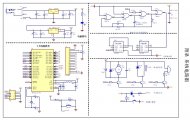基于ATmega16的电子脉搏血压计

基于ATmega16的电子脉搏血压计(任务书,开题报告,外文翻译,论文15600字)
摘 要
随着生活优越性的不断提高,人们对于自己的身体健康越来越重视,对于能够在生活中随时检测自己身体健康的便携仪器也重视起来。血压和脉搏是体现生命健康特征的两种重要指标,人们迫切地需要能够在家庭中使用并且操作简单的智能检测血压和脉搏的装置。
本文详细介绍了电子脉搏血压计的整体设计方案,并且按照设计模块详细阐述了整个系统的功能和基本工作原理。其中详细分析了各个模块的电路组成和功能,并对系统的设计做出详细分析。硬件电路设计部分,控制模块采用ATmega16作为核心器件实现对系统的自动控制,传感器模块采用新型的医用专用电容式压力传感器Sensor101采集信号,显示模块采用LCD1602显示血压和脉搏,另外通过按键可进入检测状态,通过提示模块可以进行状态提醒。软件设计部分通过C语言编写算法获取血压和脉搏的具体值。
测试效果表明,本设计能够达到所需要达到的各项功能要求。
关键词:血压 脉搏 ATmega16 电容式压力传感器
The Electronic Pulse Pressure Meter
Abstract
Along with social development, people's living standard gets higher and higher and they are more concerned with their health. Blood pressure and pulse are the body's vital physiological parameters so it is urgent for people to be able to use and operate a simple intelligent detection device for blood pressure and pulse testing at home.
[资料来源:Doc163.com]
This paper introduces the overall design of electronic pulse pressure meter, and according to the design module, the function and the basic working principle of the whole system are described in detail. This paper analyzes the electronic components and functions of each module, and analyzes the design of the system. The design adopts ATmega16 as the main controller. A new type of medical capacitive pressure sensor for blood pressure sensor is Sensor101,human computer interaction with LCD1602 showed blood pressure and pulse, and detected by setting the keys. The specific values of blood pressure and pulse are acquired by C language.
It is sure that the function of each module has all met the requirements in this design.
Key words: Blood pressure; Blood Pulse; ATmega16; Capacitive pressure sensor
[资料来源:www.doc163.com]



目 录
摘要 I
ABSTRACT II
第一章 引言 1
1.1 课题背景 1
1.2 研究现状 1
1.3 课题任务 2
1.4 论文结构 2
第二章 方案设计 4
2.1 脉搏血压计概述 4 [资料来源:https://www.doc163.com]
2.1.1 脉搏血压计简述 4
2.1.2 脉搏血压计使用注意事项 4
2.2 系统方案设计 4
2.2.1 整体设计 4
2.2.2 传感器选择 5
2.2.3 控制器选择 5
2.2.4 显示模块 6
第三章 硬件电路设计 7
3.1 传感器模块 7
3.2 控制模块 8
3.2.1 单片机简介 8
3.2.2 控制电路 10
3.3 按键模块 11
3.4 提示模块 11
3.5 显示模块 12
3.6 电源模块 13
3.7 驱动模块 14
第四章 系统软件设计 15
4.1 软件开发环境简介 15
4.1.1 ICCAVR 15
4.1.2 PROGISP 15
4.1.3 熔丝位简介 16
4.2 C语言简介 17
4.3 软件结构分析 17 [来源:http://www.doc163.com]
4.4 主程序设计 17
4.4.1 脉搏算法简介 17
4.4.2 血压算法简介 18
4.4.3 主程序流程设计 20
4.5 LCD液晶显示 23
4.6 USART接口 25
第五章 系统调试与结果展示 27
5.1 系统调试 27
5.1.1 模块调试 27
5.1.2 程序调试 28
5.1.3 系统调试(联调) 28
5.2 结果展示 30
第六章 总结 34
致谢 39
参考文献 40
附录 系统电路图 37
